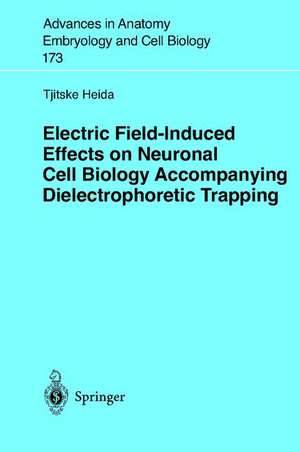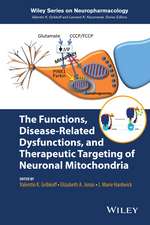Electric Field-Induced Effects on Neuronal Cell Biology Accompanying Dielectrophoretic Trapping: Advances in Anatomy, Embryology and Cell Biology, cartea 173
Autor Tjitske Heidaen Limba Engleză Paperback – 23 iun 2003
Din seria Advances in Anatomy, Embryology and Cell Biology
- 5%
 Preț: 1146.33 lei
Preț: 1146.33 lei - 5%
 Preț: 721.19 lei
Preț: 721.19 lei - 15%
 Preț: 637.13 lei
Preț: 637.13 lei -
 Preț: 381.81 lei
Preț: 381.81 lei - 15%
 Preț: 644.95 lei
Preț: 644.95 lei - 5%
 Preț: 1025.16 lei
Preț: 1025.16 lei - 15%
 Preț: 689.97 lei
Preț: 689.97 lei - 15%
 Preț: 577.07 lei
Preț: 577.07 lei - 15%
 Preț: 580.36 lei
Preț: 580.36 lei - 5%
 Preț: 393.51 lei
Preț: 393.51 lei -
 Preț: 408.66 lei
Preț: 408.66 lei -
![Die Schlüpfdrüse der Geburtshelferkröte (Alytes o. obstetricans [LAURENTI]) und anderer Froschlurche](https://i4.books-express.ro/bs/9783662239742/die-schluepfdruese-der-geburtshelferkroete-alytes-o-obstetricans-laurenti-und-anderer-froschlurche.jpg) Preț: 408.27 lei
Preț: 408.27 lei - 5%
 Preț: 1090.61 lei
Preț: 1090.61 lei - 5%
 Preț: 705.11 lei
Preț: 705.11 lei - 5%
 Preț: 706.04 lei
Preț: 706.04 lei - 5%
 Preț: 357.61 lei
Preț: 357.61 lei - 5%
 Preț: 704.59 lei
Preț: 704.59 lei - 5%
 Preț: 705.11 lei
Preț: 705.11 lei - 5%
 Preț: 359.42 lei
Preț: 359.42 lei - 5%
 Preț: 711.52 lei
Preț: 711.52 lei - 15%
 Preț: 635.47 lei
Preț: 635.47 lei - 15%
 Preț: 631.72 lei
Preț: 631.72 lei - 15%
 Preț: 633.35 lei
Preț: 633.35 lei - 15%
 Preț: 632.37 lei
Preț: 632.37 lei - 5%
 Preț: 706.60 lei
Preț: 706.60 lei - 15%
 Preț: 631.07 lei
Preț: 631.07 lei - 5%
 Preț: 707.13 lei
Preț: 707.13 lei - 5%
 Preț: 707.33 lei
Preț: 707.33 lei - 5%
 Preț: 359.60 lei
Preț: 359.60 lei - 5%
 Preț: 707.69 lei
Preț: 707.69 lei - 5%
 Preț: 707.13 lei
Preț: 707.13 lei - 5%
 Preț: 708.06 lei
Preț: 708.06 lei - 5%
 Preț: 706.41 lei
Preț: 706.41 lei - 5%
 Preț: 708.78 lei
Preț: 708.78 lei - 5%
 Preț: 705.68 lei
Preț: 705.68 lei - 5%
 Preț: 705.11 lei
Preț: 705.11 lei - 5%
 Preț: 706.77 lei
Preț: 706.77 lei - 15%
 Preț: 635.15 lei
Preț: 635.15 lei - 15%
 Preț: 631.07 lei
Preț: 631.07 lei - 5%
 Preț: 706.77 lei
Preț: 706.77 lei - 5%
 Preț: 706.04 lei
Preț: 706.04 lei - 5%
 Preț: 710.79 lei
Preț: 710.79 lei - 5%
 Preț: 705.32 lei
Preț: 705.32 lei - 15%
 Preț: 633.19 lei
Preț: 633.19 lei - 15%
 Preț: 629.09 lei
Preț: 629.09 lei - 15%
 Preț: 633.53 lei
Preț: 633.53 lei - 15%
 Preț: 632.70 lei
Preț: 632.70 lei - 15%
 Preț: 633.68 lei
Preț: 633.68 lei - 18%
 Preț: 773.72 lei
Preț: 773.72 lei - 15%
 Preț: 630.43 lei
Preț: 630.43 lei
Preț: 630.43 lei
Preț vechi: 741.68 lei
-15% Nou
Puncte Express: 946
Preț estimativ în valută:
120.63€ • 126.40$ • 99.72£
120.63€ • 126.40$ • 99.72£
Carte tipărită la comandă
Livrare economică 12-26 aprilie
Preluare comenzi: 021 569.72.76
Specificații
ISBN-13: 9783540006374
ISBN-10: 3540006370
Pagini: 92
Ilustrații: IX, 80 p. 36 illus.
Dimensiuni: 155 x 235 x 5 mm
Greutate: 0.14 kg
Ediția:Softcover reprint of the original 1st ed. 2003
Editura: Springer Berlin, Heidelberg
Colecția Springer
Seria Advances in Anatomy, Embryology and Cell Biology
Locul publicării:Berlin, Heidelberg, Germany
ISBN-10: 3540006370
Pagini: 92
Ilustrații: IX, 80 p. 36 illus.
Dimensiuni: 155 x 235 x 5 mm
Greutate: 0.14 kg
Ediția:Softcover reprint of the original 1st ed. 2003
Editura: Springer Berlin, Heidelberg
Colecția Springer
Seria Advances in Anatomy, Embryology and Cell Biology
Locul publicării:Berlin, Heidelberg, Germany
Public țintă
ResearchCuprins
1 Introduction.- 1.1 Neuro-Electronic Interfacing.- 1.2 Culturing Neuronal Cells.- 1.3 Positioning and Culturing Neuronal Cells on a Microelectrode Array.- 1.4 Dielectrophoresis.- 1.5 Scope of This Review.- 2 Dielectrophoretic Trapping of Neuronal Cells.- 2.1 Theory.- 2.2 Materials.- 2.3 Theoretical Description of Dielectrophoretic Trapping.- 2.4 Experimental Description of Dielectrophoretic Trapping.- 3 Exposing Neuronal Cells to Electric Fields.- 3.1 Theory.- 3.2 Theoretical Investigation of Induced Membrane Potentials of Neuronal Cells.- 3.3 Experimental Investigation of Neuronal Membrane Breakdown.- 4 Investigating Viability of Dielectrophoretically Trapped Neuronal Cells.- 4.1 Viability of Neuronal Cells Trapped at a High Frequency.- 4.2 Viability of Neuronal Cells Trapped at Low Frequencies.- 4.3 Recording Neuronal Activity.- 5 Summary.- References.
Textul de pe ultima copertă
The concept of the cultured neuron probe was induced by the possible selective stimulation of nerves for functional recovery after a neural lesion or disease. The probe consists of a micro-electrode array on top of which groups of neuronal cells are cultured. An efficient method to position groups of neuronal cells on top of the stimulation sites of the micro-electrode array is developed. With negative dielectrophoretic forces, produced by non-uniform electric fields on polarizable particles, neuronal cells are trapped. Experimental results and model simulations describe the trapping process and its effect on neuronal cell viability.












